Wheat Export Market: Growth in Australian Agricultural Sector Analysis
VerifiedAdded on 2023/06/12
|8
|1479
|407
Report
AI Summary
This report provides an economic analysis of the growth in the Australian agricultural sector, focusing specifically on wheat exports. It examines the past and present demand and supply dynamics of wheat, incorporating relevant data, news articles, and diagrams to illustrate trends. The report highlights Australia's position as a major wheat producer and exporter, with a particular emphasis on Western Australia's significant contribution. It discusses the quality characteristics of Australian wheat, its various milling grades, and key international markets like Indonesia, South Korea, and Japan. The report also addresses challenges such as regional economic instability due to unbalanced marketing prices and the impact of rising wheat prices in other regions. Recommendations for the Australian government include implementing policies to ensure quality control and stabilize wheat pricing to maintain a competitive edge in the global market. The report concludes with a positive outlook for the future, anticipating continued growth in government revenue from wheat exports if strategic policies are effectively implemented. Desklib provides access to this and other solved assignments for students.
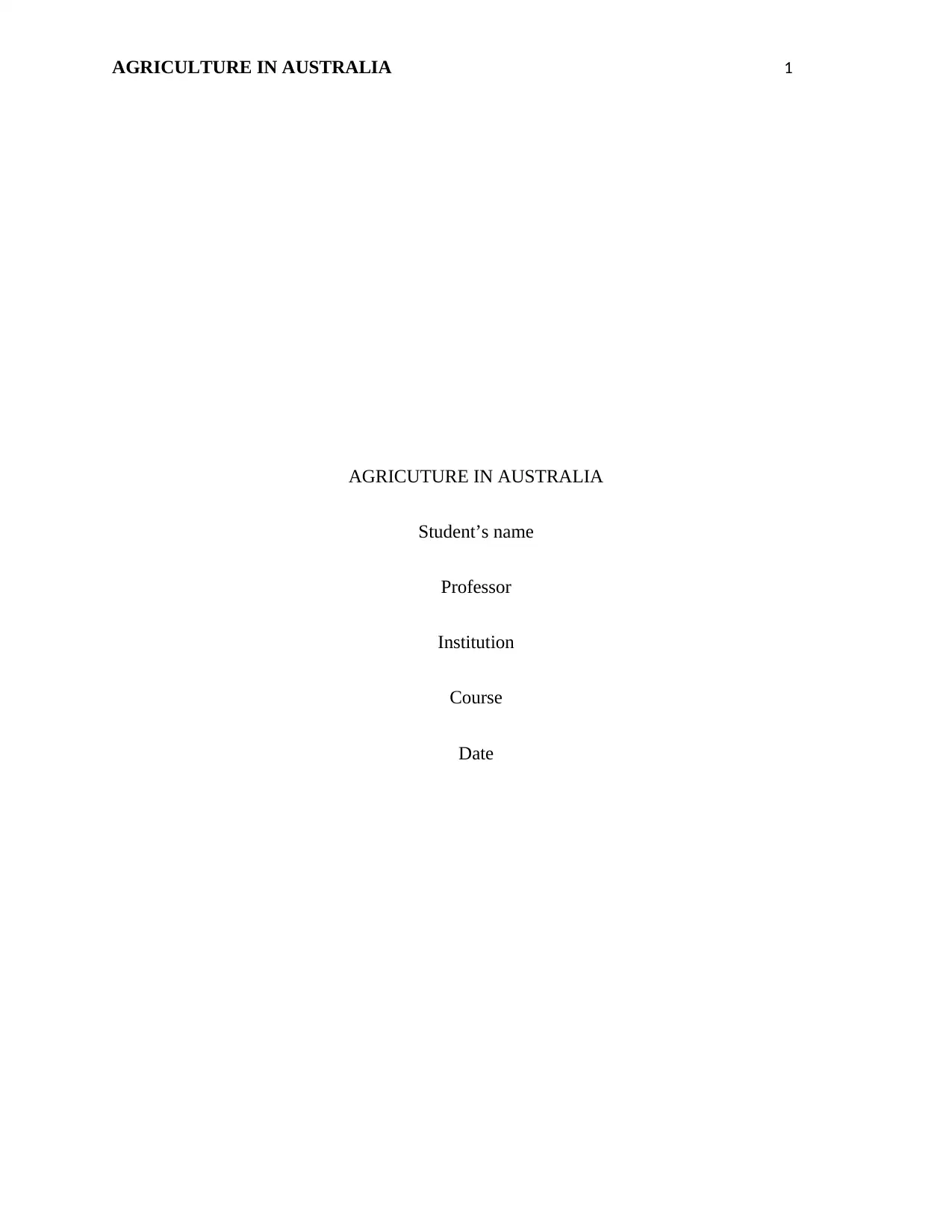
AGRICULTURE IN AUSTRALIA 1
AGRICUTURE IN AUSTRALIA
Student’s name
Professor
Institution
Course
Date
AGRICUTURE IN AUSTRALIA
Student’s name
Professor
Institution
Course
Date
Paraphrase This Document
Need a fresh take? Get an instant paraphrase of this document with our AI Paraphraser
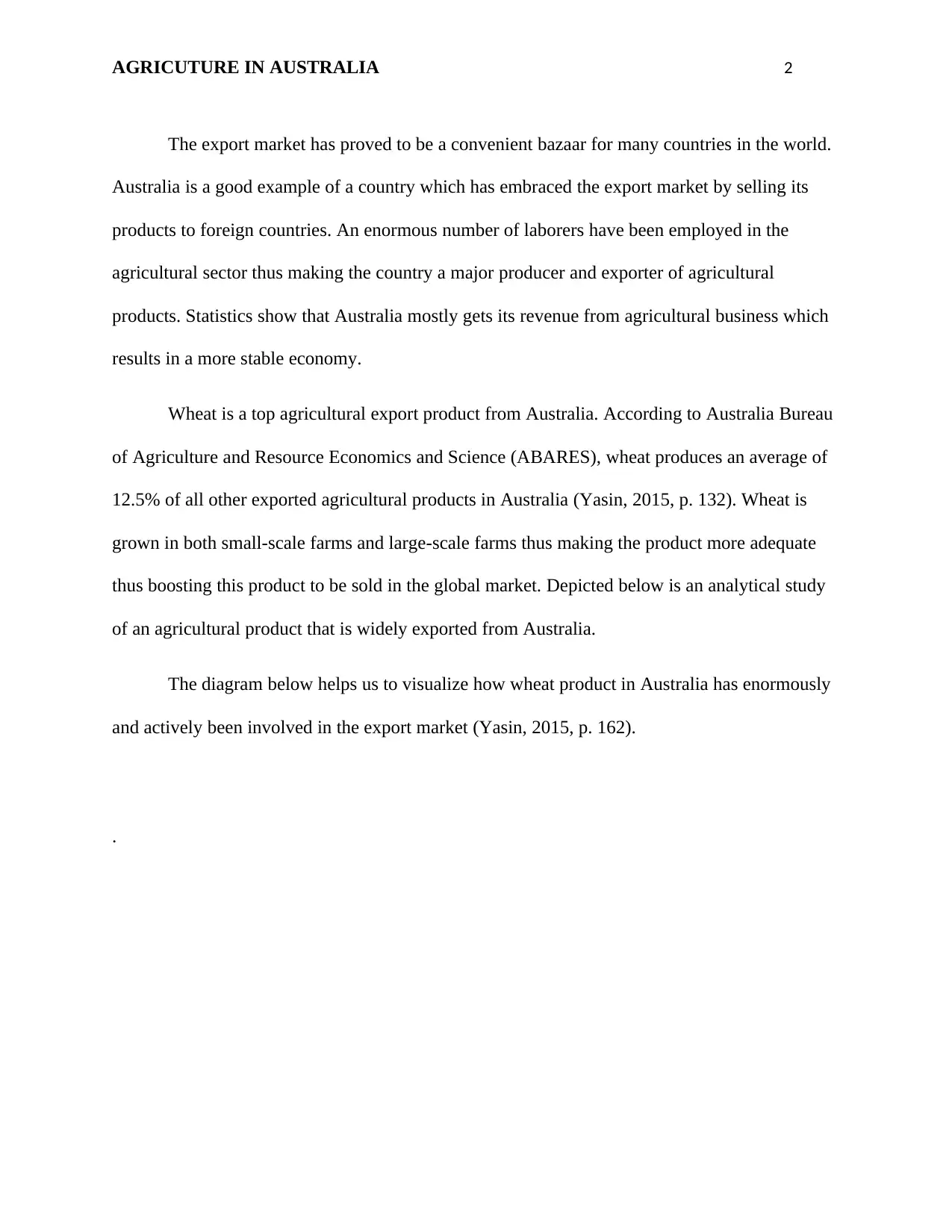
AGRICUTURE IN AUSTRALIA 2
The export market has proved to be a convenient bazaar for many countries in the world.
Australia is a good example of a country which has embraced the export market by selling its
products to foreign countries. An enormous number of laborers have been employed in the
agricultural sector thus making the country a major producer and exporter of agricultural
products. Statistics show that Australia mostly gets its revenue from agricultural business which
results in a more stable economy.
Wheat is a top agricultural export product from Australia. According to Australia Bureau
of Agriculture and Resource Economics and Science (ABARES), wheat produces an average of
12.5% of all other exported agricultural products in Australia (Yasin, 2015, p. 132). Wheat is
grown in both small-scale farms and large-scale farms thus making the product more adequate
thus boosting this product to be sold in the global market. Depicted below is an analytical study
of an agricultural product that is widely exported from Australia.
The diagram below helps us to visualize how wheat product in Australia has enormously
and actively been involved in the export market (Yasin, 2015, p. 162).
.
The export market has proved to be a convenient bazaar for many countries in the world.
Australia is a good example of a country which has embraced the export market by selling its
products to foreign countries. An enormous number of laborers have been employed in the
agricultural sector thus making the country a major producer and exporter of agricultural
products. Statistics show that Australia mostly gets its revenue from agricultural business which
results in a more stable economy.
Wheat is a top agricultural export product from Australia. According to Australia Bureau
of Agriculture and Resource Economics and Science (ABARES), wheat produces an average of
12.5% of all other exported agricultural products in Australia (Yasin, 2015, p. 132). Wheat is
grown in both small-scale farms and large-scale farms thus making the product more adequate
thus boosting this product to be sold in the global market. Depicted below is an analytical study
of an agricultural product that is widely exported from Australia.
The diagram below helps us to visualize how wheat product in Australia has enormously
and actively been involved in the export market (Yasin, 2015, p. 162).
.
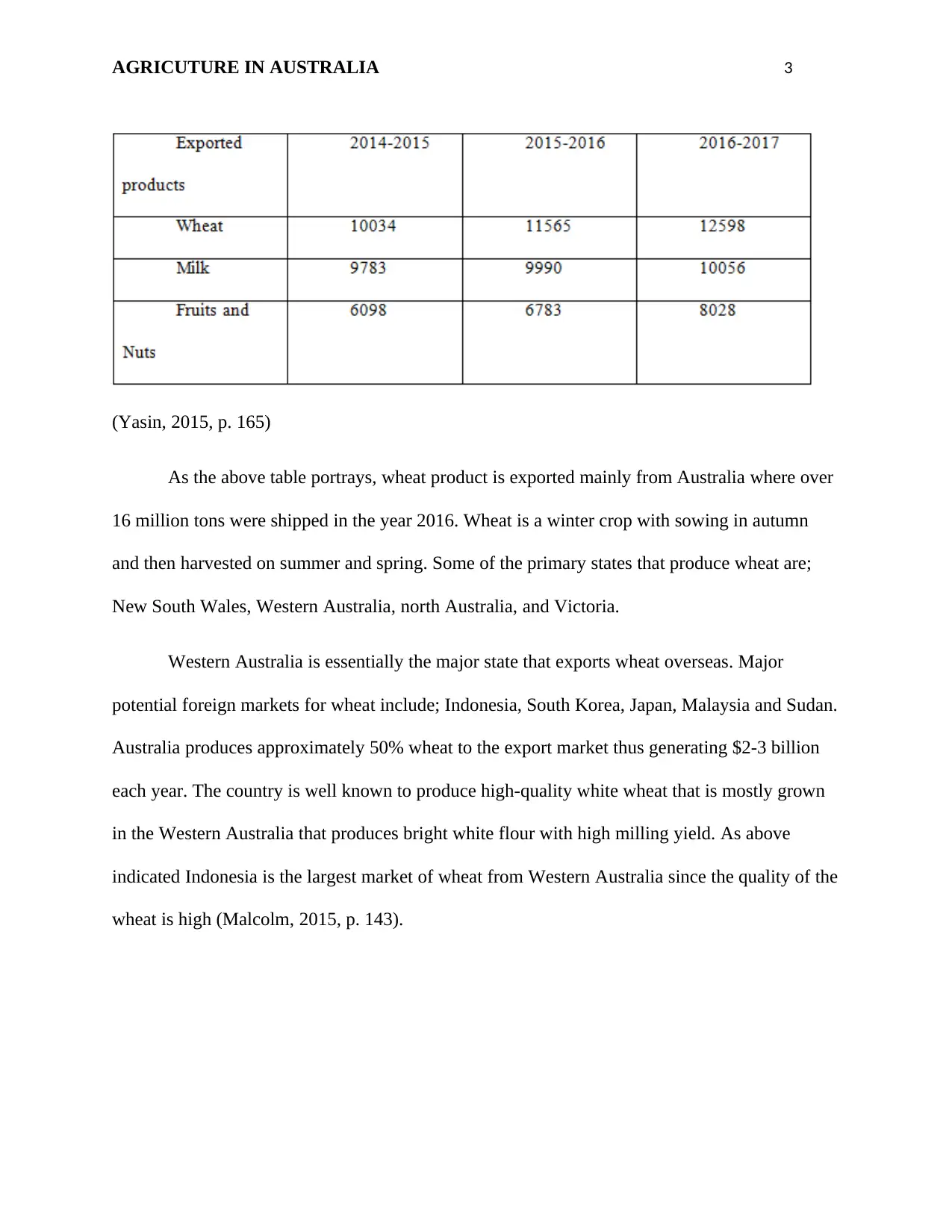
AGRICUTURE IN AUSTRALIA 3
(Yasin, 2015, p. 165)
As the above table portrays, wheat product is exported mainly from Australia where over
16 million tons were shipped in the year 2016. Wheat is a winter crop with sowing in autumn
and then harvested on summer and spring. Some of the primary states that produce wheat are;
New South Wales, Western Australia, north Australia, and Victoria.
Western Australia is essentially the major state that exports wheat overseas. Major
potential foreign markets for wheat include; Indonesia, South Korea, Japan, Malaysia and Sudan.
Australia produces approximately 50% wheat to the export market thus generating $2-3 billion
each year. The country is well known to produce high-quality white wheat that is mostly grown
in the Western Australia that produces bright white flour with high milling yield. As above
indicated Indonesia is the largest market of wheat from Western Australia since the quality of the
wheat is high (Malcolm, 2015, p. 143).
(Yasin, 2015, p. 165)
As the above table portrays, wheat product is exported mainly from Australia where over
16 million tons were shipped in the year 2016. Wheat is a winter crop with sowing in autumn
and then harvested on summer and spring. Some of the primary states that produce wheat are;
New South Wales, Western Australia, north Australia, and Victoria.
Western Australia is essentially the major state that exports wheat overseas. Major
potential foreign markets for wheat include; Indonesia, South Korea, Japan, Malaysia and Sudan.
Australia produces approximately 50% wheat to the export market thus generating $2-3 billion
each year. The country is well known to produce high-quality white wheat that is mostly grown
in the Western Australia that produces bright white flour with high milling yield. As above
indicated Indonesia is the largest market of wheat from Western Australia since the quality of the
wheat is high (Malcolm, 2015, p. 143).
⊘ This is a preview!⊘
Do you want full access?
Subscribe today to unlock all pages.

Trusted by 1+ million students worldwide
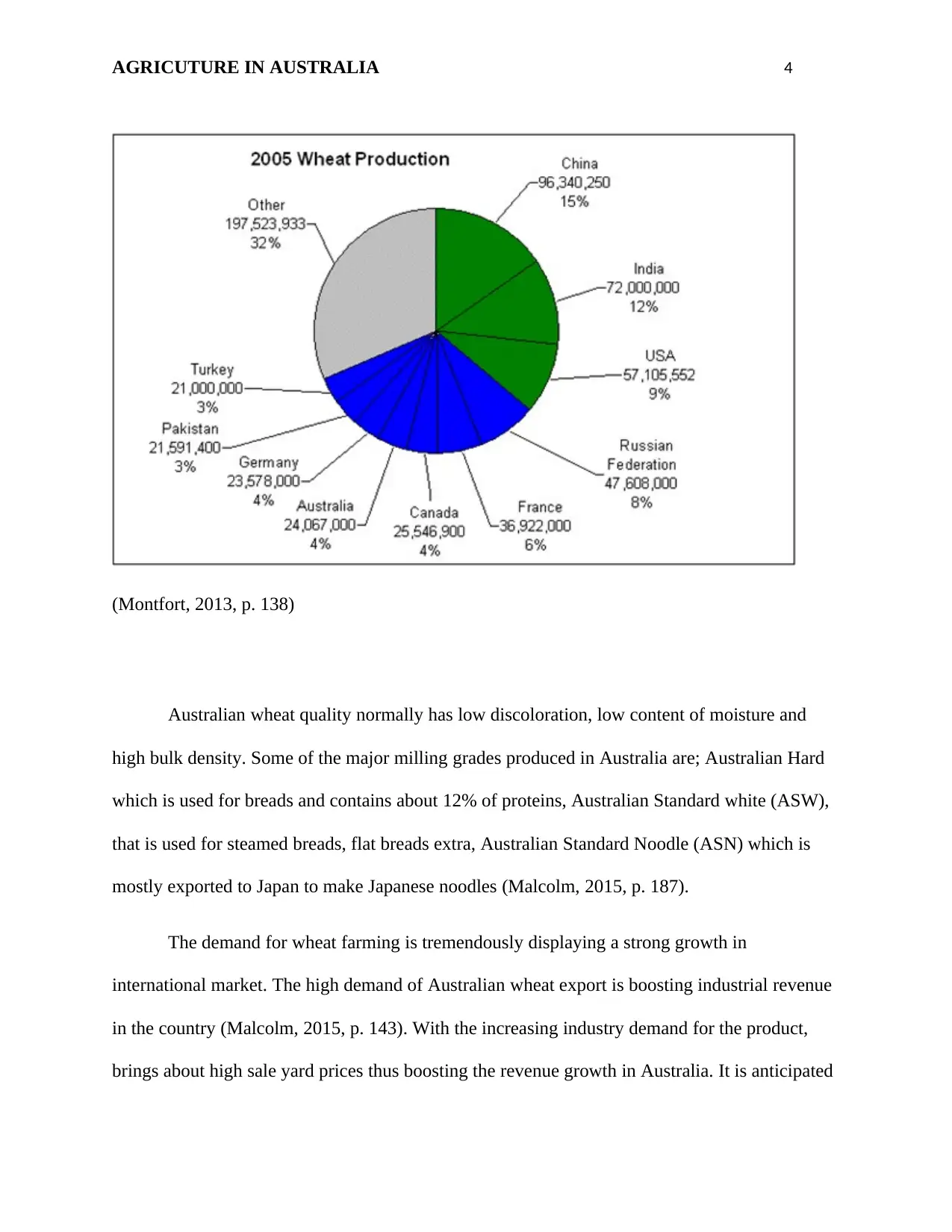
AGRICUTURE IN AUSTRALIA 4
(Montfort, 2013, p. 138)
Australian wheat quality normally has low discoloration, low content of moisture and
high bulk density. Some of the major milling grades produced in Australia are; Australian Hard
which is used for breads and contains about 12% of proteins, Australian Standard white (ASW),
that is used for steamed breads, flat breads extra, Australian Standard Noodle (ASN) which is
mostly exported to Japan to make Japanese noodles (Malcolm, 2015, p. 187).
The demand for wheat farming is tremendously displaying a strong growth in
international market. The high demand of Australian wheat export is boosting industrial revenue
in the country (Malcolm, 2015, p. 143). With the increasing industry demand for the product,
brings about high sale yard prices thus boosting the revenue growth in Australia. It is anticipated
(Montfort, 2013, p. 138)
Australian wheat quality normally has low discoloration, low content of moisture and
high bulk density. Some of the major milling grades produced in Australia are; Australian Hard
which is used for breads and contains about 12% of proteins, Australian Standard white (ASW),
that is used for steamed breads, flat breads extra, Australian Standard Noodle (ASN) which is
mostly exported to Japan to make Japanese noodles (Malcolm, 2015, p. 187).
The demand for wheat farming is tremendously displaying a strong growth in
international market. The high demand of Australian wheat export is boosting industrial revenue
in the country (Malcolm, 2015, p. 143). With the increasing industry demand for the product,
brings about high sale yard prices thus boosting the revenue growth in Australia. It is anticipated
Paraphrase This Document
Need a fresh take? Get an instant paraphrase of this document with our AI Paraphraser
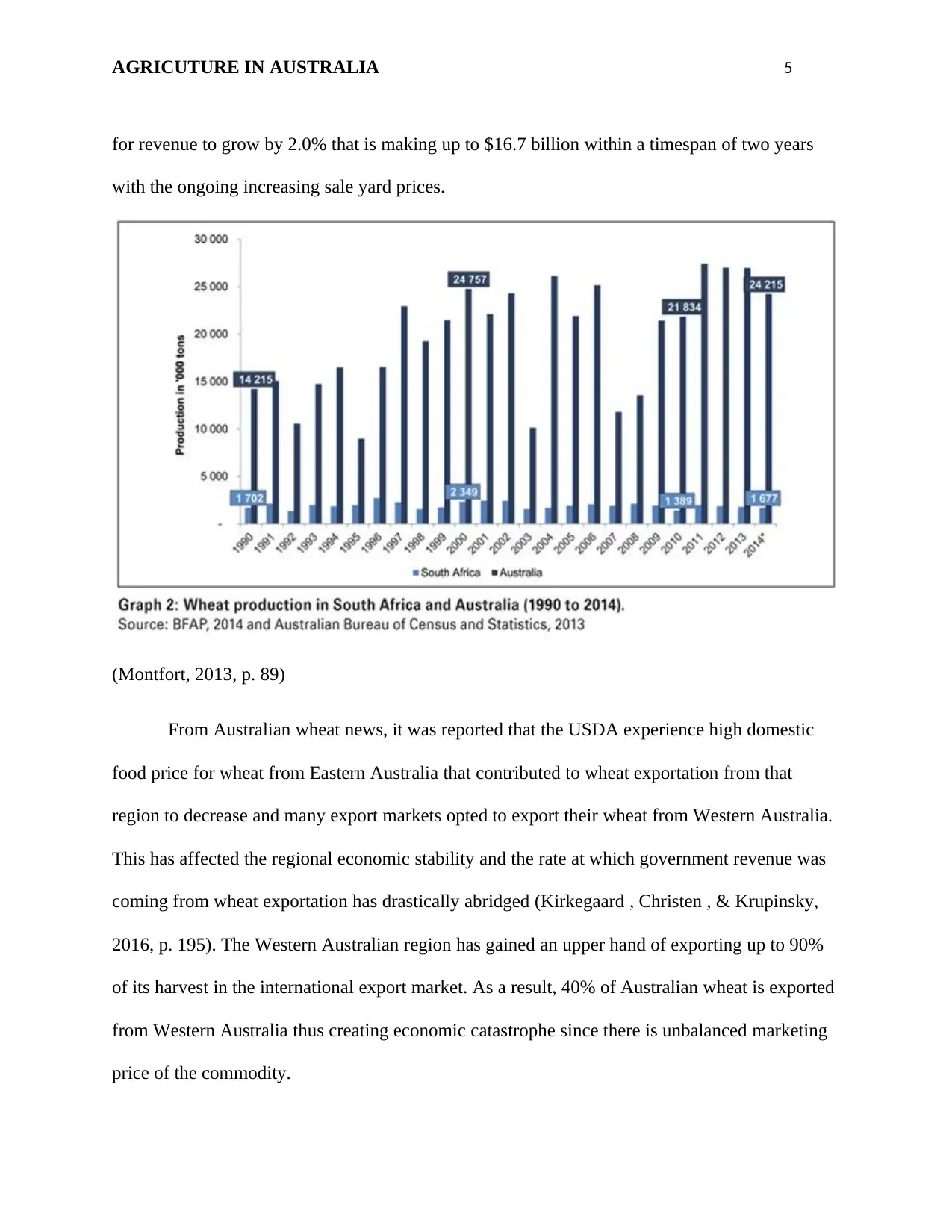
AGRICUTURE IN AUSTRALIA 5
for revenue to grow by 2.0% that is making up to $16.7 billion within a timespan of two years
with the ongoing increasing sale yard prices.
(Montfort, 2013, p. 89)
From Australian wheat news, it was reported that the USDA experience high domestic
food price for wheat from Eastern Australia that contributed to wheat exportation from that
region to decrease and many export markets opted to export their wheat from Western Australia.
This has affected the regional economic stability and the rate at which government revenue was
coming from wheat exportation has drastically abridged (Kirkegaard , Christen , & Krupinsky,
2016, p. 195). The Western Australian region has gained an upper hand of exporting up to 90%
of its harvest in the international export market. As a result, 40% of Australian wheat is exported
from Western Australia thus creating economic catastrophe since there is unbalanced marketing
price of the commodity.
for revenue to grow by 2.0% that is making up to $16.7 billion within a timespan of two years
with the ongoing increasing sale yard prices.
(Montfort, 2013, p. 89)
From Australian wheat news, it was reported that the USDA experience high domestic
food price for wheat from Eastern Australia that contributed to wheat exportation from that
region to decrease and many export markets opted to export their wheat from Western Australia.
This has affected the regional economic stability and the rate at which government revenue was
coming from wheat exportation has drastically abridged (Kirkegaard , Christen , & Krupinsky,
2016, p. 195). The Western Australian region has gained an upper hand of exporting up to 90%
of its harvest in the international export market. As a result, 40% of Australian wheat is exported
from Western Australia thus creating economic catastrophe since there is unbalanced marketing
price of the commodity.
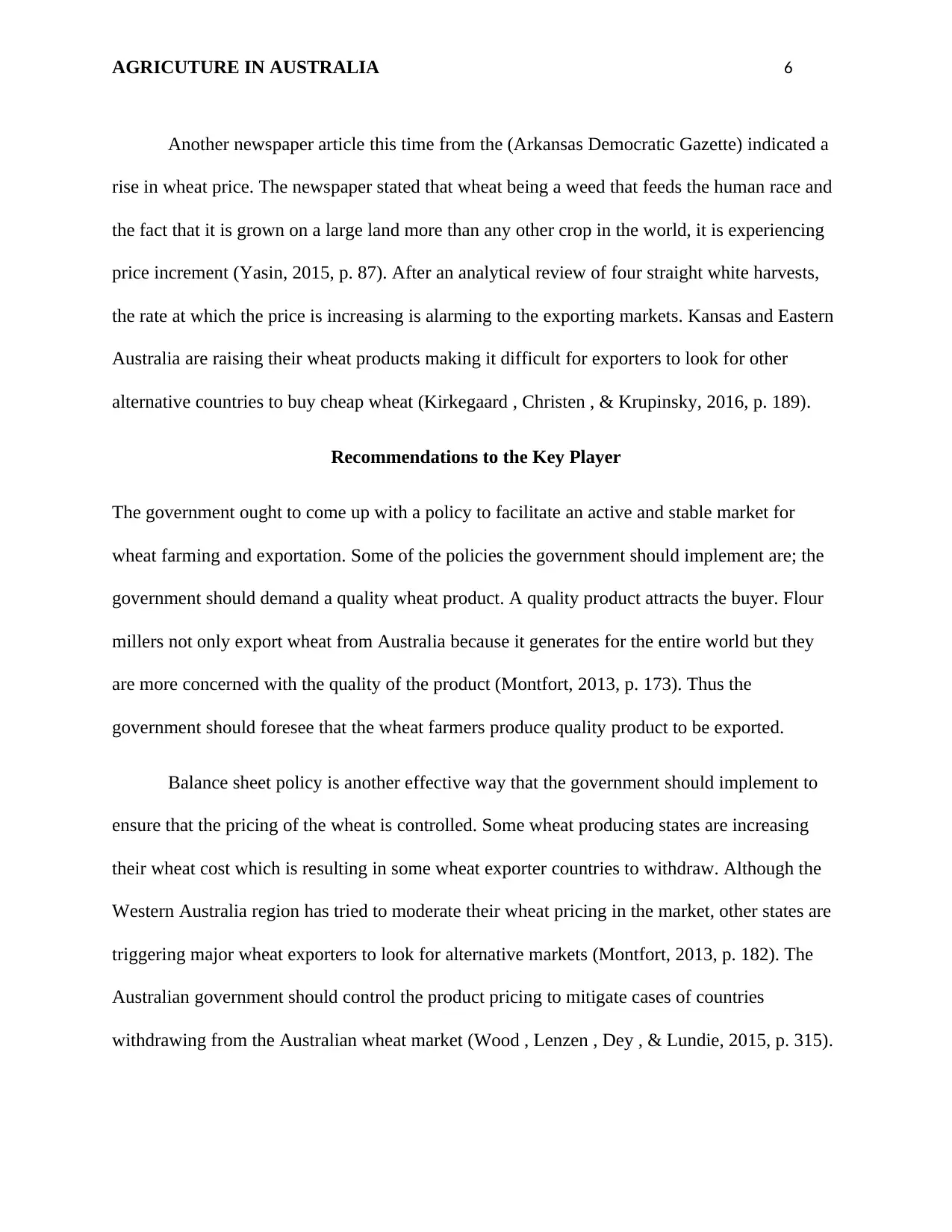
AGRICUTURE IN AUSTRALIA 6
Another newspaper article this time from the (Arkansas Democratic Gazette) indicated a
rise in wheat price. The newspaper stated that wheat being a weed that feeds the human race and
the fact that it is grown on a large land more than any other crop in the world, it is experiencing
price increment (Yasin, 2015, p. 87). After an analytical review of four straight white harvests,
the rate at which the price is increasing is alarming to the exporting markets. Kansas and Eastern
Australia are raising their wheat products making it difficult for exporters to look for other
alternative countries to buy cheap wheat (Kirkegaard , Christen , & Krupinsky, 2016, p. 189).
Recommendations to the Key Player
The government ought to come up with a policy to facilitate an active and stable market for
wheat farming and exportation. Some of the policies the government should implement are; the
government should demand a quality wheat product. A quality product attracts the buyer. Flour
millers not only export wheat from Australia because it generates for the entire world but they
are more concerned with the quality of the product (Montfort, 2013, p. 173). Thus the
government should foresee that the wheat farmers produce quality product to be exported.
Balance sheet policy is another effective way that the government should implement to
ensure that the pricing of the wheat is controlled. Some wheat producing states are increasing
their wheat cost which is resulting in some wheat exporter countries to withdraw. Although the
Western Australia region has tried to moderate their wheat pricing in the market, other states are
triggering major wheat exporters to look for alternative markets (Montfort, 2013, p. 182). The
Australian government should control the product pricing to mitigate cases of countries
withdrawing from the Australian wheat market (Wood , Lenzen , Dey , & Lundie, 2015, p. 315).
Another newspaper article this time from the (Arkansas Democratic Gazette) indicated a
rise in wheat price. The newspaper stated that wheat being a weed that feeds the human race and
the fact that it is grown on a large land more than any other crop in the world, it is experiencing
price increment (Yasin, 2015, p. 87). After an analytical review of four straight white harvests,
the rate at which the price is increasing is alarming to the exporting markets. Kansas and Eastern
Australia are raising their wheat products making it difficult for exporters to look for other
alternative countries to buy cheap wheat (Kirkegaard , Christen , & Krupinsky, 2016, p. 189).
Recommendations to the Key Player
The government ought to come up with a policy to facilitate an active and stable market for
wheat farming and exportation. Some of the policies the government should implement are; the
government should demand a quality wheat product. A quality product attracts the buyer. Flour
millers not only export wheat from Australia because it generates for the entire world but they
are more concerned with the quality of the product (Montfort, 2013, p. 173). Thus the
government should foresee that the wheat farmers produce quality product to be exported.
Balance sheet policy is another effective way that the government should implement to
ensure that the pricing of the wheat is controlled. Some wheat producing states are increasing
their wheat cost which is resulting in some wheat exporter countries to withdraw. Although the
Western Australia region has tried to moderate their wheat pricing in the market, other states are
triggering major wheat exporters to look for alternative markets (Montfort, 2013, p. 182). The
Australian government should control the product pricing to mitigate cases of countries
withdrawing from the Australian wheat market (Wood , Lenzen , Dey , & Lundie, 2015, p. 315).
⊘ This is a preview!⊘
Do you want full access?
Subscribe today to unlock all pages.

Trusted by 1+ million students worldwide
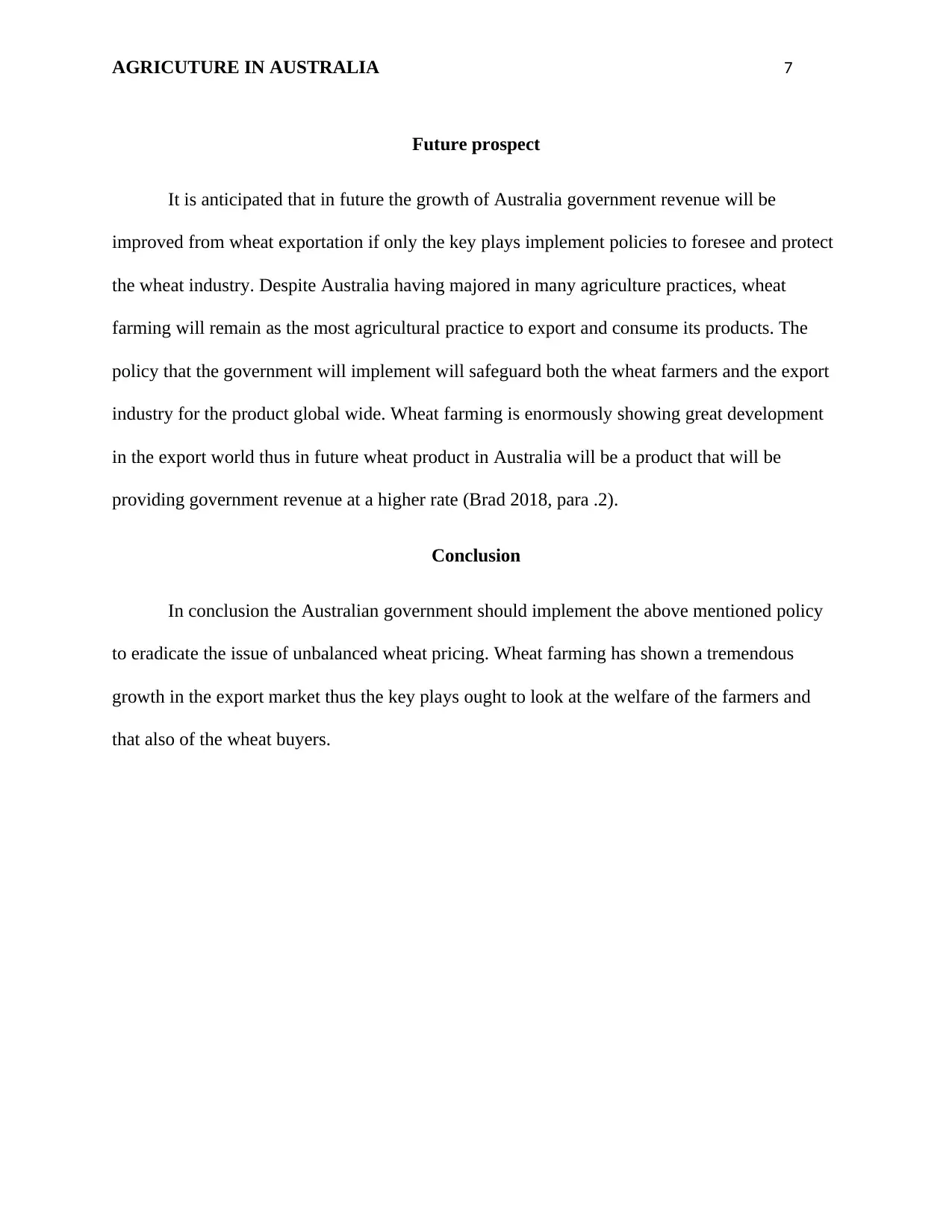
AGRICUTURE IN AUSTRALIA 7
Future prospect
It is anticipated that in future the growth of Australia government revenue will be
improved from wheat exportation if only the key plays implement policies to foresee and protect
the wheat industry. Despite Australia having majored in many agriculture practices, wheat
farming will remain as the most agricultural practice to export and consume its products. The
policy that the government will implement will safeguard both the wheat farmers and the export
industry for the product global wide. Wheat farming is enormously showing great development
in the export world thus in future wheat product in Australia will be a product that will be
providing government revenue at a higher rate (Brad 2018, para .2).
Conclusion
In conclusion the Australian government should implement the above mentioned policy
to eradicate the issue of unbalanced wheat pricing. Wheat farming has shown a tremendous
growth in the export market thus the key plays ought to look at the welfare of the farmers and
that also of the wheat buyers.
Future prospect
It is anticipated that in future the growth of Australia government revenue will be
improved from wheat exportation if only the key plays implement policies to foresee and protect
the wheat industry. Despite Australia having majored in many agriculture practices, wheat
farming will remain as the most agricultural practice to export and consume its products. The
policy that the government will implement will safeguard both the wheat farmers and the export
industry for the product global wide. Wheat farming is enormously showing great development
in the export world thus in future wheat product in Australia will be a product that will be
providing government revenue at a higher rate (Brad 2018, para .2).
Conclusion
In conclusion the Australian government should implement the above mentioned policy
to eradicate the issue of unbalanced wheat pricing. Wheat farming has shown a tremendous
growth in the export market thus the key plays ought to look at the welfare of the farmers and
that also of the wheat buyers.
Paraphrase This Document
Need a fresh take? Get an instant paraphrase of this document with our AI Paraphraser
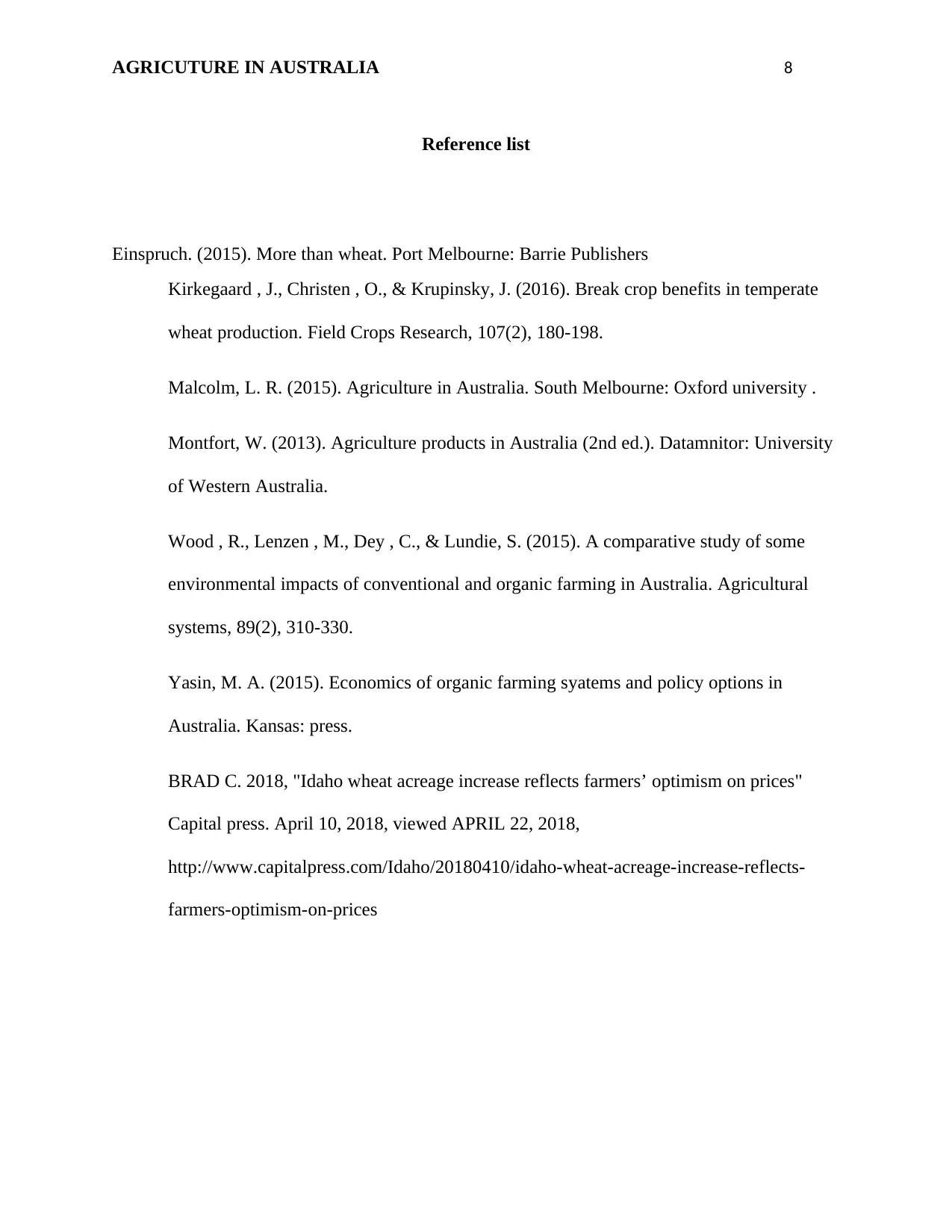
AGRICUTURE IN AUSTRALIA 8
Reference list
Einspruch. (2015). More than wheat. Port Melbourne: Barrie Publishers
Kirkegaard , J., Christen , O., & Krupinsky, J. (2016). Break crop benefits in temperate
wheat production. Field Crops Research, 107(2), 180-198.
Malcolm, L. R. (2015). Agriculture in Australia. South Melbourne: Oxford university .
Montfort, W. (2013). Agriculture products in Australia (2nd ed.). Datamnitor: University
of Western Australia.
Wood , R., Lenzen , M., Dey , C., & Lundie, S. (2015). A comparative study of some
environmental impacts of conventional and organic farming in Australia. Agricultural
systems, 89(2), 310-330.
Yasin, M. A. (2015). Economics of organic farming syatems and policy options in
Australia. Kansas: press.
BRAD C. 2018, "Idaho wheat acreage increase reflects farmers’ optimism on prices"
Capital press. April 10, 2018, viewed APRIL 22, 2018,
http://www.capitalpress.com/Idaho/20180410/idaho-wheat-acreage-increase-reflects-
farmers-optimism-on-prices
Reference list
Einspruch. (2015). More than wheat. Port Melbourne: Barrie Publishers
Kirkegaard , J., Christen , O., & Krupinsky, J. (2016). Break crop benefits in temperate
wheat production. Field Crops Research, 107(2), 180-198.
Malcolm, L. R. (2015). Agriculture in Australia. South Melbourne: Oxford university .
Montfort, W. (2013). Agriculture products in Australia (2nd ed.). Datamnitor: University
of Western Australia.
Wood , R., Lenzen , M., Dey , C., & Lundie, S. (2015). A comparative study of some
environmental impacts of conventional and organic farming in Australia. Agricultural
systems, 89(2), 310-330.
Yasin, M. A. (2015). Economics of organic farming syatems and policy options in
Australia. Kansas: press.
BRAD C. 2018, "Idaho wheat acreage increase reflects farmers’ optimism on prices"
Capital press. April 10, 2018, viewed APRIL 22, 2018,
http://www.capitalpress.com/Idaho/20180410/idaho-wheat-acreage-increase-reflects-
farmers-optimism-on-prices
1 out of 8
Related Documents
Your All-in-One AI-Powered Toolkit for Academic Success.
+13062052269
info@desklib.com
Available 24*7 on WhatsApp / Email
![[object Object]](/_next/static/media/star-bottom.7253800d.svg)
Unlock your academic potential
Copyright © 2020–2025 A2Z Services. All Rights Reserved. Developed and managed by ZUCOL.





